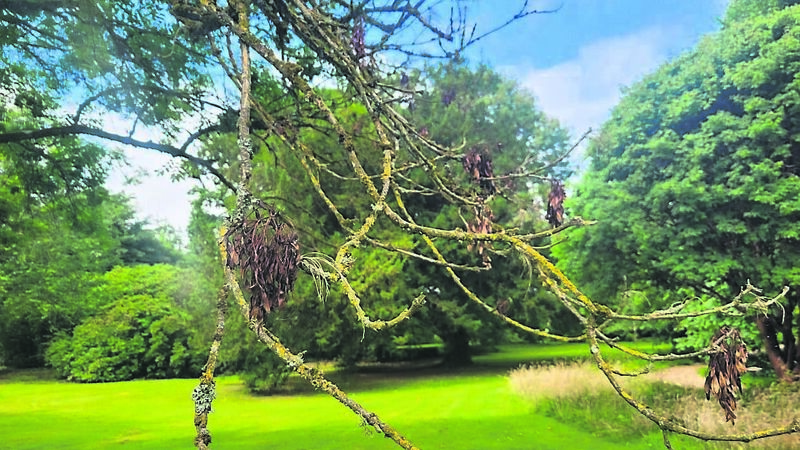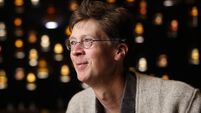John Arnold: I could never sleep in the dark - this energy crisis cured that!

This man had died and, as was the custom, he was ‘waked’ at home on the night of his death. ’Twas winter time and cold weather.
The wake was ‘below in the room’ and when the night went on after midnight, just his widow and a few women were by the side of the deceased man - we’ll call him Paddy.
There were five or six men above in the kitchen sitting around the fire. Around 4am, the women left the praying to have a cup of tea. The men in the kitchen, with the fair dint of smoking and drinking and talking, had left the fire go down, never thinking of putting a few sods of turf or timber on it.
Well, when the widow saw the sad state of the fire, she said: “Aw lads, why didn’t ye keep a good blaze going, Paddy was always fond of the heat - I hope there’s a good fire going where he’s gone tonight!”
Talk about keeping the home fires blazing!
I’m doing my bit for saving energy lately. For all of my life, I could never sleep in the dark, ’tis true. I just had to have a light on in the room or the door wide open and a light on in the landing.
Often, over the years, the power might go off during the night - maybe due to a storm, an ESB outage, or it might just be the trip-switch at the meter box went.
If ’twas coming on dawn, I could pull back the curtains and that early morning light would give some degree of comfort and I might get another hour shut-eye.
I suppose it’s a kind of an abnormal fear but apparently many people suffer, like me, from nyctophobia.
Anyway, while I often throw my hands in the air looking at new- fangled modern technology, I must admit, once in a while along comes a beauty. Well, we got a yoke called a Nite Lite, a small little thingamajig that you just plug into a socket and it gives off a faint blue light. It more or less glows in the dark, not really lighting up the room at all, but it takes away the 100% darkness that bothers me.
Never one for reading when sleep beckons, this little invention disproves the theory that ‘you can’t teach old dogs new tricks’.
This energy crisis is one of the most troubling things in years. Even before the Russians invaded Ukraine, oil, gas and electricity bills were sky-rocketing. Those who deny climate change is the result of human intervention see no problem with continuing to use polluting fuels ad infinitum. Let’s face it, that’s no longer an option, and though that might not be a pleasant fact, it’s pure true.
With the ice caps melting and carbon emissions rising, we truly face a crisis. I know many will say ‘But sure, Ireland isn’t even a drop in the ocean as regards climate change in comparison with China and other huge countries’. Fair enough, but we have to change too.
More than 30 years ago, we planted a few acres of a glen with trees. If we were hoping to make money fairly quickly, we should have planted conifers that could be clear-felled by now. Back then, however, our glen wasn’t very productive and a bit steep for ordinary farming.
We planted ash and oak trees - mainly ash. I love broadleaf trees for many reasons. They are beautiful to look at, changing as they do with the seasons and like a mirror of the year.
The beauty of trees is beyond compare and the simple walk in the woods is a pleasure beyond measure.
Our house was built in the 1870s so trying to ‘retro fit’ it with heat exchange pumps or underfloor heating would be an impossible task. We never had central heating of any kind and never yearned for it. With an open fireplace and, in recent years, a stove, the fuel needs of the house were well provided by our plantation as well as by the planting of previous generations.
As a fuel source, ash is amazing. I’m open to correction, but I think no other timber can be cut down today and burned ‘green’ tonight. If you tried to burn fresh spruce, sycamore, oak, alder or furze ’twould be hissing and spitting in the grate.
Ash is amazing as a fuel with its unique properties and ability to give off such mighty heat when fresh.
It worries me now when I hear that the burning of timber in homes will only be allowed if the timber has been dried for a year or two. I’m sure there is some scientific research gone into this proposal, but we did an experiment ourselves a few years back. We compared the heat generated from ash blocks cut in three different years. The three-year-old dried logs burned as good as any, but you could pass your hand through the flames and you’d not get burnt.
The dry ash burns as brightly as anything else, but apparently, when the ‘sap’ is gone, it’s like taking the ‘fuel’ from the wood - plenty flame but little heat.
In our wood, I think there are about 100 oak trees. They are 33 years old now but in comparison to the ash they look tiny - but then, a century only brings an oak tree to it’s ‘teenage’ years.
Over the years, the oaks have kind of self-thinned with the weakest and crooked specimens dying off leaving healthy trees. Hopefully they will grow on in Garryantaggart Glen for centuries to come.
Then, when timber such as ash might be considered a valuable ‘cash’ crop’ for furniture and hurley making as well as for fuel, along comes the awful ‘Ash Dieback’ disease.
The disease came to Ireland from European countries some years ago, when diseased saplings were unwittingly brought in. Initially, it was thought the disease would and could only effect very young trees, maybe up to ten or 15 years of age. Alas, this has not proved to be correct.
In recent months, I have seen mighty ash trees - of maybe 50 or 60 years of age - sadly dying from this terrible disease.
Because of the disease now being so prevalent, no ash trees have been planted in this country with over a decade. It will be just awful if the disease sweeps all our noble ash trees.
Just when we thought our native woodlands might bring us a partial solution to fuel poverty and forever be part of our native game of hurling, this disease comes with terrible consequences.
I presume new jobs will have to be created now - I mean Inspectors going around making sure our firewood is dry enough to burn. Perhaps we could get a subsidy on overcoats and woolly jumpers, flannel pyjamas and eiderdowns - now wouldn’t those measures save energy and keep us warm?
(Joyce Kilmer)







 App?
App?




